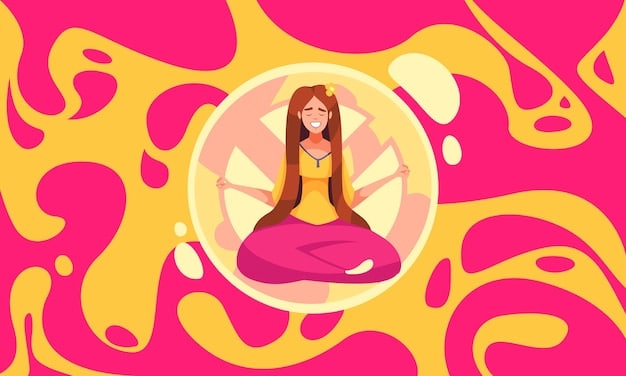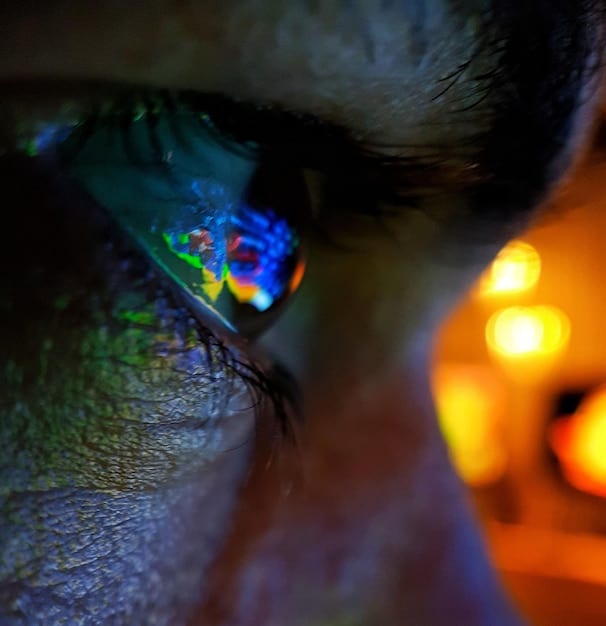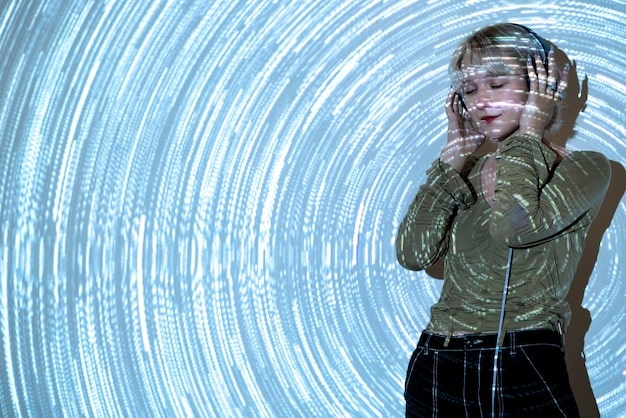Boost Your Creativity: Visualization Meditation Techniques

Boost your creativity by harnessing the power of visualization meditation, a technique that uses mental imagery to unlock innovative thinking and problem-solving skills.
Unlock your inner artist and innovator with visualization meditation. This powerful technique uses your mind’s eye to stimulate creativity, helping you break through barriers and explore new perspectives.
What is Visualization Meditation?
Visualization meditation, at its core, is about using your imagination to create vivid mental images. It’s a technique that taps into the power of your subconscious mind to promote relaxation, focus, and creativity.
But how does it work, and why is it so effective? Let’s explore the fundamentals of this transformative practice.
The Science Behind Visualization
Neuroscience suggests that our brains respond to imagined scenarios almost as vividly as they do to real ones. When you visualize, you activate similar neural pathways as if you were actually experiencing the event. This can lead to real changes in your thoughts, feelings, and behaviors.
Key Components of Visualization Meditation
- Setting a Clear Intention: Before you begin, define what you want to achieve or create.
- Creating a Mental Image: Use all your senses to build a detailed picture in your mind.
- Engaging Emotionally: Feel the emotions associated with your desired outcome.
- Repeating Regularly: Consistent practice reinforces the neural pathways associated with your visualization.
Visualization meditation isn’t just about daydreaming; it’s a focused, intentional practice that can lead to tangible results.

Benefits of Visualization for Creativity
The benefits of visualization meditation extend far beyond simple relaxation. It’s a potent tool for enhancing creativity in various aspects of life.
Let’s delve into the specific ways visualization can unlock your creative potential.
Boosting Innovation and Problem-Solving
Visualization can help you approach problems from different angles by allowing you to mentally experiment with various solutions. By “seeing” the outcome, you can identify potential obstacles and develop innovative strategies.
Overcoming Creative Blocks
When faced with a creative block, visualization can provide a mental escape route. Imagine yourself succeeding, feeling inspired, and effortlessly generating ideas. This can help you break free from self-doubt and performance anxiety.
Enhancing Focus and Concentration
The act of visualizing requires sustained focus. Regular practice strengthens your ability to concentrate, which is essential for creative work. A focused mind is more efficient and productive.
Visualization offers a multitude of benefits that directly contribute to a more creative and innovative mindset.
How to Practice Visualization Meditation
Getting started with visualization meditation is simple. All you need is a quiet space, a few minutes of time, and an open mind.
Here’s a step-by-step guide to help you begin your visualization journey.
Step 1: Find a Quiet Space
Choose a place where you won’t be disturbed. This could be a cozy corner in your home, a quiet park, or any location where you feel comfortable and relaxed.
Step 2: Get Comfortable
Sit or lie down in a comfortable position. Close your eyes and take a few deep breaths to center yourself.
Step 3: Set Your Intention
Decide what you want to visualize. Do you want to solve a problem, generate new ideas, or simply feel more inspired? Clearly define your goal.
Step 4: Create Your Mental Image
Use all your senses to create a vivid mental picture. What do you see, hear, smell, taste, and feel in your visualization?
Step 5: Engage Emotionally
Allow yourself to feel the emotions associated with your desired outcome. If you’re visualizing success, feel the joy and excitement of achieving your goal.
Step 6: Practice Regularly
Consistency is key. Aim to practice visualization meditation for at least 10-15 minutes each day. Over time, you’ll find that your ability to visualize becomes stronger and more effective.
With regular practice, visualization meditation can become a powerful tool for unlocking your creative potential.
Visualization Techniques for Different Creative Fields
Visualization meditation can be tailored to suit various creative fields and disciplines. Whether you’re a writer, artist, musician, or entrepreneur, there are specific visualization techniques that can enhance your work.
Let’s explore some field-specific applications of visualization.
For Writers
Visualize your characters in detail. What are their physical attributes, personalities, and motivations? “See” them interacting with each other and “hear” their conversations. This can help you create more authentic and compelling stories.
For Artists
Imagine your finished artwork. Visualize the colors, textures, and composition. Feel the emotions you want to convey through your art. This can guide your creative process and help you achieve your artistic vision.
For Musicians
Hear the music in your mind before you play it. Visualize yourself performing flawlessly, feeling the rhythm and engaging with the audience. This can improve your performance and boost your confidence.
For Entrepreneurs
Visualize your successful business. “See” your products or services being used by satisfied customers. “Hear” positive feedback and “feel” the excitement of growth and success. This can inspire you to take action and overcome challenges.

Tips for Enhancing Your Visualization Practice
To make your visualization meditation practice even more effective, consider incorporating these tips and techniques.
Here are some suggestions to help you deepen your visualization experience.
Use Sensory Details
Engage all your senses to create a richer, more immersive visualization. Imagine not just what you see, but also what you hear, smell, taste, and feel.
Incorporate Affirmations
Combine visualization with positive affirmations. Repeat empowering statements that reinforce your desired outcome. For example, “I am creative,” “I am inspired,” or “I am successful.”
Use Guided Visualizations
If you find it difficult to visualize on your own, try using guided visualizations. These are recordings that lead you through a specific scenario, providing detailed imagery and suggestions.
Keep a Visualization Journal
Document your visualization experiences in a journal. This can help you track your progress, identify patterns, and gain deeper insights into your creative process.
By incorporating these tips, you can enhance your visualization practice and unlock even greater creative potential.
Common Challenges and How to Overcome Them
Like any skill, visualization meditation takes practice. It’s normal to encounter challenges along the way.
Let’s address some common hurdles and explore strategies for overcoming them.
Difficulty Creating Mental Images
Some people find it challenging to create vivid mental images. If this is the case for you, start small. Begin by visualizing simple objects or scenes, and gradually work your way up to more complex scenarios.
Mind Wandering
It’s common for your mind to wander during meditation. When you notice your thoughts drifting, gently redirect your attention back to your visualization. Don’t get frustrated; simply acknowledge the distraction and refocus.
Lack of Patience
Visualization meditation isn’t a quick fix. It takes time and consistent effort to see results. Be patient with yourself and trust the process. Celebrate small victories and stay committed to your practice.
Self-Doubt
Self-doubt can sabotage your visualization efforts. Challenge negative thoughts and replace them with positive affirmations. Believe in your ability to create and achieve your goals.
By addressing these common challenges with patience and perseverance, you can overcome obstacles and unlock the full potential of visualization meditation.
| Key Point | Brief Description |
|---|---|
| 💡 Visualization Basics | Use imagination for vivid mental images. |
| 🚀 Creativity Boost | Enhance innovation and problem-solving skills. |
| 🧘 Practice Steps | Find quiet space, set intention, create images. |
| 🎯 Field Specifics | Adapt techniques for writing, art, music, etc. |
FAQ
▼
The best time to practice is when you can be consistent. Many find morning or evening ideal, as there are fewer distractions and more time to relax and focus.
▼
Start with 10-15 minutes and gradually increase the duration as you become more comfortable. Even short, regular sessions can provide significant benefits.
▼
Yes, visualization meditation can help reduce anxiety by promoting relaxation and shifting your focus away from negative thoughts and worries. Visualize peaceful scenes.
▼
Not everyone visualizes in the same way. Some people “see” vivid images, while others experience feelings or sensations. Focus on what comes naturally to you.
▼
Aim to practice daily for the best results. Consistency is key to developing your visualization skills and experiencing the full benefits of this technique.
Conclusion
Visualization meditation is a powerful technique for boosting creativity and unlocking your inner potential. By incorporating this practice into your daily routine, you can enhance your problem-solving skills, overcome creative blocks, and achieve your goals with greater ease and confidence.





